Grassroots takes on a whole new meaning under the leadership of Princeton Secondary School teacher Gordon Bibby. Bibby identified a small plot of land that needed some help and got busy. The small piece of land had been recently disturbed during the construction of the new water system meant for the airport residents, the Industrial park and east Princeton. The water system is now done and operating, but Bibby noticed that there was some after math of the construction phase.
A patch of land 100 square metres across had been left raw and torn up. The surface was bare except for a few weeds that were trying to root themselves in. It was an ideal piece for a small group to tackle as a restoration project.
It all began as a result of an assignment Bibby was given as part of his degree homework. He has been in the throes of obtaining his diploma in Ecological Restoration through the University of Victoria when this particular bit of land came to his attention.
A few letters later and Bibby had rounded up a substantial amount of support for him and his students to tackle the project head on. Starting with the PSS PAC, Bibby was able to find a group willing to cover the expense of the native grasses that wold be planted. The Regional District kicked in some money and sent along an invasive plant specialist in the name of Lisa Scott to educate the group on weeds. Labour, topsoil and manure were supplied by the school district. While the Town of Princeton supplied the eager crew with a water truck and snow fencing to keep the roaming range cattle out. Last, but not least was a donation from Home Hardware. “They supplied us with blood meal,” said Bibby. It along with the dehydrated coyote urine I will be sprinkling around the perimeter should help act as a deer repellent.
Right from the get go Bibby was able to bring the actual costs of the land restoration project down substantially with his able and willing students lending a hand. “The project cost about $7/square meter,” Bibby stated, “but would have cost double or triple that if we had to pay someone to do this.” From start to finish the project took several weeks to complete from the planning stage to the digging in the dirt stage.
“I had to take on some sort of land restoration project on my own as part of the requirements of my diploma,” said Bibby “and I could have taken on something smaller on my own, but I thought that something like this was a good way to show the youth how to fix the world I a small way one little piece at a time. We prepared the land by weeding first,” Bibby continued. “Then, we installed log pieces to stabilize the bank, added a bluebird house courtesy of the woodwork department, added nutrients and then, planted the native grasses.” The students hauled six yards of blended soil up to the site in homemade sling carriers and the manure material. Snow fencing was installed and the project was complete.
“These kids have been great sports,” Bibby said. “It is quite inspiring to see the kids getting involved helping out like this. It is good for them to see and experience this stuff.”
Bibby wanted to make sure he sent his heartfelt gratitude to all his supporters including Brad Hope, Ted Coyne and John Schneider who helped out on a personal level. “Cooper’s needs to be thanked too,” Bibby continued. “They are providing us with a bbq lunch.” Some dirt under their fingernails later and a full stomach was the end to a job well done.
